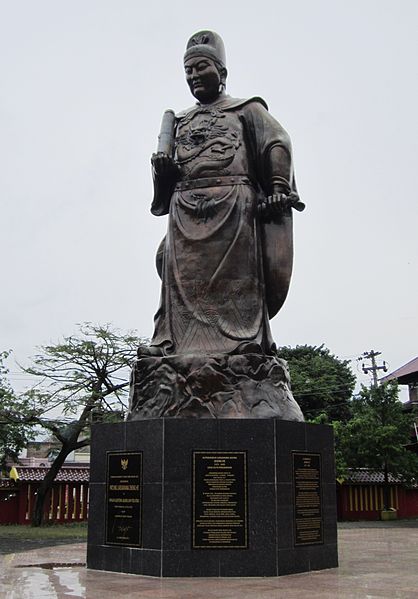During the Ming dynasty, Chinese Emperor Yongle organized a series of naval expeditions in the Indian Ocean basin. The expeditions were led by eunuch admiral Zheng He. He was a Muslin from Yunnan who was the emperor’s trusted adviser. The Ming admiral navigated a fleet of large ships around the globe in seven expeditions from 1405 until 1433 that are unmatched in world history. The expeditions were not only impressive in their size but also in the distance. The emperor organized the expeditions to benefit China as an attempt to impress foreign people of the power and might of the Ming dynasty and to impose imperial control over foreign trade.1
Wanting to impress the Ming power on the world and showing that China had many resources, Emperor Yongle gave orders to construct great baochuan or treasure ships. The ships were enormous in size with nine masts and four decks. The treasure ships were said to be able to accommodate more than 500 passengers and massive amounts of cargo. The ships were supposedly twice as long as any of the European ships that existed at the time, measuring 137 meters long. Also, compared to other ships of the time, the treasure ships were wider in relation to their length at approximately 55 meters wide. The ships’ wideness along with floating anchors casted off the sides of the ship and balanced rudders, which could be raised and lowered helped with the ships’ stability during the expeditions. Lastly, watertight compartments were used to give the treasure ships strength to withstand the long expeditions.2

During Zheng He’s seven voyages to what the Chinese called the “Western Ocean,” which is the Indian Ocean, he brought back many treasures and envoys from far empires. The first voyage was the mighty armada. On July 11, 1405 the fleet left to travel around the Indian Ocean and was comprised of 317 ships with 27,870 men on board. Its first port call was Vijaya, the capital of Champa and then continued onto the island of Java carefully avoiding Chen Zuyi pirates on their way there. It then proceeded to its main stop of Cochin and the kingdom of Calicut. On their return, He defeated Chen Zuyi pirates killing more than 5,000 of them and sinking 10 of their ships. Chen Zuyi and two of his top associates were captured and then beheaded on October 2, 1407. This first voyage increased China’s prestige in the eastern Indian Ocean basin and established a large trading center in Malacca.3
The second voyage was not commanded by He himself, but was organized by him. It was a voyage of 68 ships traveling to Calicut to attend the inauguration of a new king and to return foreign ambassadors from Sumatra, India, and other places that had traveled to China on the first voyage. The third voyage was again commanded by He and traveled to Ceylon. When they arrived at Ceylon, He brought a tablet as a gesture to appease the religious people of Ceylon that praised Buddha, Siva, and Allah. The Ceylon warrior Alakeswara was offended by the tablet, refused to erect it and drove He and his people back to their ships. Zheng He captured Alakeswara and took him back to China.4
The fourth voyage was He’s most ambitious voyage to this point. He made his usual stops, but then proceeded to the Horn of Africa and the Arabian Peninsula. At the end of this voyage, He brought a giraffe back to China. The fifth voyage was marked by the first visit to Africa. The expedition brought back a boatload of African exotic animals, including antelopes, leopards, lions, oryxes, rhinos, ostriches, zebras, and more giraffes. The giraffes were of particular interest to the Chinese as the animal was though to be the mythical creature qilin. Qilins are creatures that are known as Chinese unicorns. The benevolent creature is a cross between a horse and a dragon and its presence is believed to be a promising sign. It is believed that possessing the giraffe that He brought back helped Yongle cement his legitimacy as the second Ming emperor.5
His sixth voyage was his shortest. During this voyage he returned envoys to their home countries. In 1424, Emperor Yongle died, and his successor Xongxi, suspended naval expeditions abroad as he felt that these voyages were a costly waste of money and resources. The new emperor unfortunately only lived nine months after becoming emperor, and his son, Xuande, took over. Xuande sent He on his seventh and final voyage. The final voyage lasted for three years and visited more than fifteen different ports on the way to Kenya. It is believed that the voyage split into two groups when it reached Calicut, and He stayed there due to failing health. Zheng He died in 1433. It is unknown if he died at Calicut or on the voyage back to China.6
Despite the voyages being successful, the voyages were stopped and the ships destroyed after the seventh voyage. The new emperors that took over the country after Yongle’s death, after evaluating the cost of the voyages, believed that the priority needed to be to protect China from Mongol attacks. The voyages, however, before being stopped, returned precious items that benefited the country. By the end of the century, China passed laws that prohibited ships to be built with more than two masts. In 1525, the Chinese government ordered the destruction of all oceangoing ships and the greatest naval fleet in history was dissolved.
- Barbara Bennett Peterson, “The Ming Voyages of Cheng Ho (Zheng He), 1371-1433,” The Great Circle 16, no. 1 (1994): 43. ↵
- Sally K. Church, “Zheng He: An Investigation into the Plausibility of 450-ft Treasure Ships,” Monumenta Serica 53 (2005): 1. ↵
- Encyclopedia Britannica, December 2015, s.v. “Zheng He,” by Jung-Pang Lo. ↵
- Encyclopaedia Britannica, December 2015, s.v. “Zheng He,” by Jung-Pang Lo. ↵
- Encyclopaedia Britannica, December 2015, s.v. “Zheng He,” by Jung-Pang Lo. ↵
- Encyclopaedia Britannica, December 2015, s.v. “Zheng He,” by Jung-Pang Lo. ↵



24 comments
Matthew Swaykus
Not to often do we hear a bit of history that somehow doesn’t appear either ancient, or centered around Europe, or both. The author did a splendid job recounting the exploits of this extraordinary man. Zheng He had mind-bogglingly amazing adventures that are, in my honest opinion, a lot better than Columbus’s journey’s to the new world. We celebrate Columbus Day because it is idolizes the loyalty and determination of one man who sailed where no one else in his country had gone before, yet Zheng He was all of this and more. However, this subject is far from the point. I like the author’s approach to writing this article and I think Mr. Jaramillo did a suitable job.
Roman Olivera
Admiral Zheng He was definitely a great explore for his empire. Finding what was thought to be the mystical Chinese unicorn or giraffe had to cement his place in history as the man who had done what none was able to do before him. The untimely deaths of his supporter as well as pressures from the Mongol attacks against China would lead to a change in focus to smaller more military minded ships and well as the protection on China.
Didier Cadena
I had no idea who Zheng He was, so this article does a great job of telling me who he was. it was interesting to read about an emperor who would stage naval expeditions to show off how powerful his navy was. the article does a great job of putting all the information together and still engage the reader to continue to read the article.
Natalia Carroll-Long
He’s treasure ships show specifically how important trade was. In history class, I was always told about trade, but was never really given specific examples like your article entails. I think this goes to show that sometimes a little ambition can in fact be good. As a side note, although the Dynasties of China were quick to beak apart and change it surprises me how much they can get done. He was able to bring back so much from all over the world, even a giraffe, in his short reign.
Benjamin Voy
It is fascinating to think that the emperor carried out all of these raids just to show how powerful he was. Also that they were all successful. However it is a shame that after his death the ships were destroyed because it would have been truly extraordinary to see how powerful chinas naval army could have been if their raids continued. Also I’m surprised that the empire took such an interest in animals from Africa and wonder why they didn’t thrive in China, maybe because the climate wasn’t right for them. An extremely interesting read, well written too!
Luke Trevino
Wow, what a great article! You can tell a lot of hard work and research was placed into this article! What I thought was truly amazing was how this voyage was simply just to show the power of the dynasty! It’s insane how they were so advanced to be able to build such huge ships and travel those great distances. Overall I really enjoyed your article and would highly recommend it to others!
Alyssa Valdez
I thought that this article was very interesting! i was always interested in the dynasties during my time in high school so I really enjoyed reading your article. I can tell you put a lot of time and effort into your research and writing. What Ii thought was interesting was that they had once sailed the largest naval fleet in history across the Indian and Southern Pacific Oceans.
Sam Vandenbrink
Very good article, well written I liked the way author really summed up the entire history throughout the time. I thought it was interesting how his successor stopped allot of the work that he had going on abroad. It makes you think about how much that changed the country. Very well written article, really enjoyed the read and learned allot!
Alexis Soto
I enjoyed this article for shedding light on a topic I knew nothing about. When I think of naval history I do not think of the Chinese. I found it amazing that the Chinese despite the success of the naval expeditions did not continue them. Zheng had a vision beyond his time and was able to not just explore but show foreign powers Chinese might.
Cameron Mays
This article seemed very well researched, but could also be interpreted of you just spitting numbers and dates at us, try to go a little more in-depth with the information. What I’m attempting to say is that I want you to prove to me that you’re a master of this information. Otherwise, I enjoyed reading the article and the topic itself was very fascinating. It induces a sense of patriotism to read about how they wanted to show off their empire.